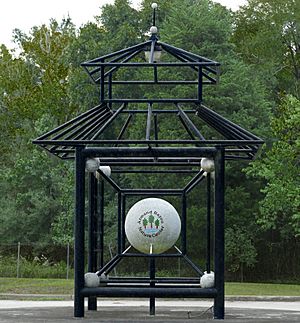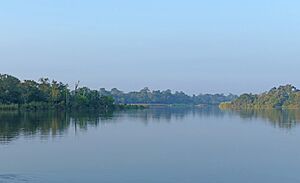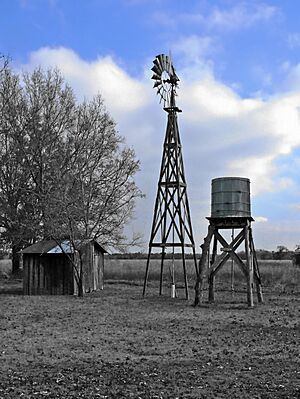Armand Bayou Nature Center facts for kids
Quick facts for kids Armand Bayou Nature Center |
|
|---|---|
 |
|
| Location | Clear Lake Area, Houston-Sugar Land-Baytown MSA, USA |
| Nearest city | Pasadena, Texas, Houston |
| Governing body | Harris County, Texas |
| Website | http://www.abnc.org |
The Armand Bayou Nature Center is a huge nature park located in Pasadena and southeast Houston. It sits between the Johnson Space Center and the Bayport Industrial District. This amazing place covers about 2,500 acres (that's over 10 square kilometers!). It's actually the biggest urban wilderness preserve in the entire United States.
This nature center is a home for more than 370 different kinds of animals. You can find birds, mammals, reptiles, and amphibians here. Over 220 types of birds either live here or stop by for a rest during their long trips. You might spot White-tailed Deer, Red-shouldered Hawks, Opossums, Armadillos, Coyotes, Raccoons, and even American Alligators. The rare Purple Martin bird also visits this area.
The Armand Bayou Nature Center is located along the Central Flyway. This is like a superhighway for birds flying across North America. The center is also part of the Great Texas Coastal Birding Trail. It's a special spot for birdwatchers and a protected area under the Texas Coastal Preserve Program.
Contents
A Look Back in Time
Early Inhabitants
Long ago, Native American tribes lived in the Armand Bayou area. We know this because archaeologists have found old tools like arrowheads, flints, and pottery. These items show that tribes like the Attakapa, Cohuilletan, and Karankawa used this area as a campsite. They likely hunted and fished here for many years.
European Settlers Arrive
In the mid-1800s, European settlers came to the area. They called the bayou "Middle Bayou." These families lived by hunting, fishing, and growing food. They would then sell their produce at local markets. There was even a large farm, or plantation, called Killkare near Mud Lake.
Protecting the Land
Later, a man named Jim West, who was in the oil business, bought much of the land. He wanted to protect it as a game preserve. West owned about 28,000 acres around the bayou until 1930. Then, a company called Humble Oil and Refining Company (now ExxonMobil) bought the land. They were interested in its natural gas and oil resources.
Development and Preservation
In 1962, a company called Friendswood Developmental Company took control of a large part of the land. They planned to build homes and industrial areas. Around this time, NASA used nearly 1,700 acres of the West Ranch property to build the Manned Spacecraft Center. In 1967, Bay Area Boulevard was built, making the area more accessible.
A local farmer named Jimmy Martyn owned 28 acres that were in the way of development. He refused to sell his land for a long time. After he passed away in 1964, his family sold the property. Today, the Armand Bayou Nature Center has a re-created 19th-century farm called Martyn Farm, named in his honor.
Many people worked hard to save the bayou from being fully developed. Biologists studied the land and found it was perfect for birds to nest. Environmentalists like Victor Emanuel and Lawrence Dexter spoke about how important it was to protect this natural area. Hana Ginzbarg was a key person who worked tirelessly to create the Nature Center.
What You Can Explore
The Armand Bayou Nature Center was officially founded in 1974. It offers many ways to explore nature:
- You can walk along a boardwalk through forests and marshes.
- See live animal displays.
- Visit platforms where you can see bison and prairie areas.
- Enjoy beautiful butterfly gardens.
The center also has several nature trails. These include the "Martyn," "Karankawa," "Marsh," "Lady Bird" (named after Lady Bird Johnson), and "Prairie" trails. These trails let visitors see different habitats like forests, prairies, marshes, and natural bayous. These types of environments were once very common in the Houston and Galveston regions.






